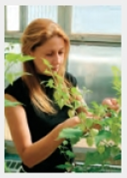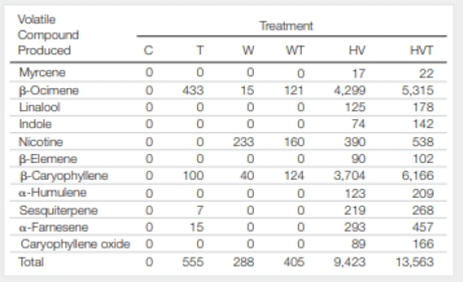

Volatile Secondary Metabolites in Plant Stress Responses In 2007, researchers Casey Delphia, Mark Mescher, and Consuelo De Moraes (pictured at left) published a study on the production of different volatile chemicals by tobacco plants in response to predation by two types of insects: western flower thrips and tobacco budworms. Their results are shown in FIGURE 30.19.

FIGURE 30.19 Volatile (airborne) compounds produced by tobacco plants in response to predation by different insects. Plants were untreated (C), attacked thrips (T), mechanically wounded (W), mechanically wounded and attacked by thrips (WT), attacked by budworms (HIV), or attacked by budworms and thrips (HVT). Values are in nanograms/day.
Which treatment elicited the greatest production of volatiles?
To find: The treatment that elicited the greatest production of volatiles in tobacco.
Concept introduction: One of the most striking features of plants is that they are capable of producing sugars by using the sun light; this phenomenon is called as photosynthesis. Thus, the sugars that are produced are primary metabolites. In addition to this, the plants also produce secondary metabolites. Secondary metabolites are mainly involved in the plant interactions with the environment where they live and help to adjust the behavior and growth of the plant. Volatile compounds produced by the plants are mainly the secondary metabolites. They are the compounds that provide smell and taste to the plants.
Explanation of Solution
Plants attacked by budworms and thrips (HVT) or budworms alone (HV) produced a total of 11 different volatiles in the amounts of 13,563 ng/day and 9,423 ng/day, respectively. The greatest production of volatile compounds produced in tobacco plant is mainly due to the treatment of HVT. It has produced 13,556 ng/day, which indicates that the treatment has a very large impact on the secondary metabolite production in tobacco.
Plants that are attacked by budworms and thrips (HVT) have produced the maximum volatile compounds in the amount of 13,563 ng/day. There are 11 compounds produced by tobacco by this treatment.
Want to see more full solutions like this?
Chapter 30 Solutions
Biology: The Unity and Diversity of Life (MindTap Course List)
Additional Science Textbook Solutions
Laboratory Manual For Human Anatomy & Physiology
Anatomy & Physiology: The Unity of Form and Function
Marine Biology (Botany, Zoology, Ecology and Evolution)
Human Anatomy & Physiology (2nd Edition)
Microbiology: An Introduction
Anatomy & Physiology
- All plants contain chlorophyll a. In addition, many plants contain other types of chlorophylls and accessory pigments. Suppose a new agricultural technology is developed in which accessory pigments are somehow embedded or injected into crops that naturally have only chlorophyll a. Explain the food production advantage that these plants could hypothetically provide if they could utilize many of these pigments rather than just one type of chlorophyllarrow_forwardAssume that two pigments, red and bluc, mix to give the normal purple color of petunia petals. Separate biochemical pathways synthesize the two pigments, as shown in pathways I and Il in the accompanying diagram. "White" refers to compounds that are not pigments (total lack of pigment results in a white petal). Red pigment forms from a yellow intermediate that is normally at a concentration loo kow to color petals. Bluc mixed with yellow makes green. Assume that no mutations are lethal. Pathway I.. White Blue Pathway I White, Yellow Red Pathway II White, White, A third pathway, whose compoundk do not contribute pelal pigmentation, normally docs not allfect the bluc and red pathways. However, if one of its intermediates (white3) should build up in concentration, it can be converted into the ycllow intermediate of the red pathway. In the diagram, the letiers A through E represent enzymes. The enzymes' correspoonding genes, all of which are unlinked, may be symbolized by the same letters.…arrow_forwardIf photosynthesizing plants are grown in thepresence of 14CO2, is every carbon atom of the glucose that is produced labeled with the radioactive carbon? Why or why not?arrow_forward
- What is the first messenger in signal transduction? What are second messengers in signal transduction? What are the three results of signal transduction? What are three types of signaling processes based on their transduction distance? Give an example for each type. What are the signaling molecules in the plant? Please describe each of them briefly. How phytohormone degradation plays important roles in signaling pathways? Explain one of the phytohormones as an example. How plants respond to the environmental stimuli (biotic and abiotic stresses)? Please explain the amechanism and give an example.arrow_forwardList 3 environmental factors discussed in lectures and give examples of physiological and biochemical perturbations in plants caused by fluctuations in these environmental factors. For each of the 3 environmental factors describe the primary effects and the secondary effects.arrow_forwardwhy some starch synthesis mutants have a reduced gravitropic response in the root and the shoot. explainarrow_forward
- A group of students have carried out an experiment to investigate the relationship between the amount of growth hormone BAP in the culture medium and the growth of shoot of jckplant.They have supplemented the medium with 4 different concentration of growth hormone which is (1 mg/L ,2 mg/L BAP,3 mg/L 4 mg/L) of BAP.According to the result after eight weeks, BAP at 2 mg/L had given better response with respect to shoot induction, shoot multiplication, length of shoot, and number of leaves per explants when compare with other amount of BAP. The lowest shoot development is BAP at 1 mg/L. What is the general conclusion that can you make from result of the experiment?arrow_forwardA group of students have carried out an experiment to investigate the relationship between the amount of growth hormone BAP in the culture medium and the growth of shoot of jckplant.They have supplemented the medium with 4 different concentration of growth hormone which is (1 mg/L ,2 mg/L BAP,3 mg/L 4 mg/L) of BAP.According to the result after eight weeks, BAP at 2 mg/L had given better response with respect to shoot induction, shoot multiplication, length of shoot, and number of leaves per explants when compare with other amount of BAP. The lowest shoot development is BAP at 1 mg/L. Discuss why 2mg/L of BAP shows the better development and 1mg/L shows the lowest development?arrow_forwardWhat is ABA ?Give it effects on plants ?arrow_forward
- Bruce Ames and his colleagues have pointed out that although detailed toxicological analysis has been conducted on synthetic chemicals, almost no information is available about the mutagenic or carcinogenic effects of the toxins produced by plants as a natural defense against fungi, insects, and animal predators. Tens of thousands of such compounds have been discovered, and he estimates that in the United States adults eat about 1.5 g of these compounds each daylevels that are approximately 10,000 times higher than those of the synthetic pesticides present in the diet. For example, cabbage contains 49 natural pesticides and metabolites, and only a few of these have been tested for their carcinogenic and mutagenic effects. a. With the introduction of new foods into the U.S. diet over the last 200 years (mangoes, kiwi fruit, tomatoes, and so forth), has there been enough time for humans to develop resistance to the mutagenic effects of the toxins present in those foods? b. The natural pesticides present in plants constitute more than 99% of the toxins we eat. Should diet planning, especially for vegetarians, take into account the doses of toxins present in the diet?arrow_forwardVolatile Secondary Metabolites in Plant Stress Responses In 2007, researchers Casey Delphia, Mark Mescher, and Consuelo De Moraes (pictured at left) published a study on the production of different volatile chemicals by tobacco plants in response to predation by two types of insects: western flower thrips and tobacco budworms. Their results are shown in FIGURE 30.20. Volatile Compound Produced Treatment C T W WT HV HVT Myrcene 0 0 0 0 17 22 -Ocimene 0 433 15 121 4.299 5.315 Linatod 0 0 0 0 125 178 indole 0 0 0 0 74 142 Nicotine 0 0 233 160 390 538 -Etemene 0 0 0 0 90 102 -Caryophyllene 0 100 40 124 3.704 6.166 -Humutene 0 0 0 0 123 209 Sesquiterpene 0 7 0 0 219 268 -Farnesene 0 15 0 0 293 457 Caryophyltene oxide 0 0 0 0 89 166 Total 0 555 288 406 9.423 13.563 FIGURE 30.20 Volatile (airborne) compounds produced by tobacco plants (Nicotiana tabacum) in response to predation by Different inserts. Plants were untreated (C), attacked by thrips (T), mechanically wounded (W). mechanically wounded and attacked by thrips (WT), attacked by budworms (HVJ, or attacked by budworms and thrips (HVTJ. Values are nanograms/day. 1. Which treatment elicited the greatest production of volatiles?arrow_forwardVolatile Secondary Metabolites in Plant Stress Responses In 2007, researchers Casey Delphia, Mark Mescher, and Consuelo De Moraes (pictured at left) published a study on the production of different volatile chemicals by tobacco plants in response to predation by two types of insects: western flower thrips and tobacco budworms. Their results are shown in FIGURE 30.20. Volatile Compound Produced Treatment C T W WT HV HVT Myrcene 0 0 0 0 17 22 -Ocimene 0 433 15 121 4.299 5.315 Linatod 0 0 0 0 125 178 indole 0 0 0 0 74 142 Nicotine 0 0 233 160 390 538 -Etemene 0 0 0 0 90 102 -Caryophyllene 0 100 40 124 3.704 6.166 -Humutene 0 0 0 0 123 209 Sesquiterpene 0 7 0 0 219 268 -Farnesene 0 15 0 0 293 457 Caryophyltene oxide 0 0 0 0 89 166 Total 0 555 288 406 9.423 13.563 FIGURE 30.20 Volatile (airborne) compounds produced by tobacco plants (Nicotiana tabacum) in response to predation by Different inserts. Plants were untreated (C), attacked by thrips (T), mechanically wounded (W). mechanically wounded and attacked by thrips (WT), attacked by budworms (HVJ, or attacked by budworms and thrips (HVTJ. Values are nanograms/day. 2. Which volatile chemical was produced in the greatest amount? What was the stimulus?arrow_forward
 Biology: The Unity and Diversity of Life (MindTap...BiologyISBN:9781305073951Author:Cecie Starr, Ralph Taggart, Christine Evers, Lisa StarrPublisher:Cengage Learning
Biology: The Unity and Diversity of Life (MindTap...BiologyISBN:9781305073951Author:Cecie Starr, Ralph Taggart, Christine Evers, Lisa StarrPublisher:Cengage Learning Human Heredity: Principles and Issues (MindTap Co...BiologyISBN:9781305251052Author:Michael CummingsPublisher:Cengage Learning
Human Heredity: Principles and Issues (MindTap Co...BiologyISBN:9781305251052Author:Michael CummingsPublisher:Cengage Learning

